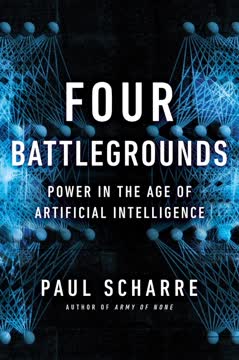Key Takeaways
1. Machine Learning: Beyond the Hype, Into Reality
Machine Learning For Dummies provides you with a view of machine learning in the real world and exposes you to the amazing feats you really can perform using this technology.
Real-world applications. Machine learning is not about killer robots or sentient androids, but about practical applications that impact daily life. From voice recognition on smartphones to recommendation systems on e-commerce sites, machine learning is already integrated into many aspects of our lives.
- AI is a broader concept that includes machine learning, but machine learning is a specific technique that enables AI to learn from data.
- Machine learning is used in fraud detection, resource scheduling, complex analysis, automation, customer service, and safety systems.
- It also has mundane but useful applications such as access control, animal protection, and predicting wait times.
Engineering and art. Machine learning has strong engineering components, relying on quantifiable theories and algorithms. However, it also has an artistic component, requiring intuition and experience to fine-tune algorithms and prepare data for optimal results.
- The artistic element involves how data is used, cleaned, and filtered.
- It also involves tuning algorithms and refining how they work.
- The experience of the scientist is essential to add value to the machine learning process.
Focus on usefulness. The emphasis of machine learning is on creating useful tools that can perform tasks in a manner never seen before. While some applications may seem mundane, they have the power to impact lives in nearly every aspect of daily life.
- Machine learning is an incredible technology, just not in the way that some people have imagined.
- The goal is to understand what machine learning can and can’t do today and what it might do in the future.
- The book focuses on concrete results of using specific algorithms to interact with big data.
2. Big Data: The Fuel for Machine Learning
Big data is substantially different from being just a large database. Yes, big data implies lots of data, but it also includes the idea of complexity and depth.
More than just size. Big data is not just about the volume of data, but also its complexity and depth. It involves datasets with many variables that require sophisticated algorithms to analyze and extract meaningful patterns.
- Big data sources include online databases, public sources, private sources, and newly created data from existing data.
- Big data presents privacy concerns, but machine learning focuses on patterns, not individual data.
- Humans can't visualize big data without help, making machine learning essential for analysis.
Diverse sources. Big data can come from various sources, including public databases, private organizations, and even existing data within an organization.
- Public sources include government, university, and non-profit databases.
- Private sources include Amazon and Google, which offer access to large datasets for a fee.
- Existing data can be transformed and combined to create new data sources for machine learning.
Data preparation. The acquisition of big data can be daunting, requiring consideration of storage, transfer, and processing.
- Data is often stored in memory for fast processing.
- Data must be cleaned and formatted to be useful for machine learning.
- New job types are emerging to massage data and make it suitable for machine learning.
3. Algorithms: The Heart of Machine Learning
An algorithm is a procedure or formula used to solve a problem.
Problem-solving tools. Algorithms are the core of machine learning, providing a systematic set of operations to perform on a given dataset. They process data through well-defined states to create an output that solves a problem.
- Algorithms must express transitions between states using a formal language that computers can understand.
- They define, refine, and execute a function specific to the problem being addressed.
- The goal is to create an output that solves a problem.
Five main techniques. Machine learning algorithms can be categorized into five main techniques, each with a different approach to problem-solving:
- Symbolic reasoning: Uses inverse deduction to solve problems.
- Connectionists: Model the brain's neurons using backpropagation.
- Evolutionaries: Rely on genetic programming and survival of the fittest.
- Bayesians: Use probabilistic inference and statistical methods.
- Analogizers: Use kernel machines to recognize patterns and analogies.
Toward a master algorithm. The ultimate goal of machine learning is to combine the technologies and strategies embraced by these five tribes to create a single algorithm that can learn anything.
- This master algorithm is still a long way off.
- This book follows the Bayesian tribe strategy, for the most part.
- The main reason to begin with statistics is that the technology is already well established and understood.
4. Training: Teaching Machines to Learn
Training is the process whereby the learner algorithm maps a flexible function to the data.
Learning from examples. Machine learning algorithms learn by analyzing examples of inputs and their corresponding outputs. The training process modifies how the algorithm views big data, enabling it to recognize patterns and make predictions.
- Training uses a subset of data to create patterns that the algorithm needs to recognize specific cases.
- The goal is to generalize the output function so that it works on data beyond the training set.
- The output is typically the probability of a certain class or a numeric value.
Three components of training. The training process relies on three key components:
- Representation: The learner algorithm creates a model that produces a given result for specific inputs.
- Evaluation: An evaluation function determines which model works best in creating a desired result.
- Optimization: The training process searches through models to determine which one works best.
Generalization is key. The secret to machine learning is generalization, which means creating a function that works on data beyond the training set.
- The learner algorithm must create a model that will produce the desired results from the input data.
- The evaluation function scores the models because more than one model could provide the required results.
- The best model is then output as the result of the training process.
5. Math: The Language of Machine Learning
The basis for machine learning is math. Algorithms determine how to interpret big data in specific ways.
Mathematical foundations. Machine learning relies heavily on mathematical concepts, including linear algebra, probability, and statistics. These concepts provide the framework for algorithms to process data and make predictions.
- Algorithms process input data in specific ways and create predictable outputs based on data patterns.
- The math basics for machine learning include vectors, matrices, and matrix calculus.
- Understanding these concepts is essential for creating and using machine learning algorithms.
Probability and statistics. Probability helps machines understand the likelihood of events, while statistics provides tools for describing and analyzing data.
- Statistics is a method of describing problems using math.
- By combining big data with statistics, you can create a machine learning environment in which the machine considers the probability of any given event.
- Machine learning uses statistical methods to solve problems.
Matrix operations. Matrices are used to organize and manipulate data efficiently. Matrix operations, such as addition, subtraction, multiplication, and transposition, are fundamental to many machine learning algorithms.
- Algorithms process data through a series of well-defined states.
- The states need not be deterministic, but the states are defined nonetheless.
- The goal is to create an output that solves a problem.
6. Validation: Ensuring Reliable Results
The main purpose of Machine Learning For Dummies is to help you understand what machine learning can and can’t do for you today and what it might do for you in the future.
Importance of validation. Validation is crucial to ensure that machine learning models are reliable and accurate. It involves testing models on out-of-sample data to assess their ability to generalize to new situations.
- Out-of-sample data is data that the algorithm has not seen during training.
- It helps to determine whether the training is a success.
- It also helps to determine whether the algorithm reacts correctly to the data it receives after the training is over.
Bias and variance. Bias and variance are two key factors that can affect the performance of machine learning models.
- Bias refers to the tendency of a model to make systematic errors.
- Variance refers to the sensitivity of a model to changes in the training data.
- Finding the right balance between bias and variance is essential for creating effective models.
Validation techniques. Various techniques are used for validating machine learning models, including:
- Train/test split: Dividing data into training and testing sets.
- Cross-validation: Using multiple folds of data for training and testing.
- Bootstrapping: Creating multiple samples of data with replacement.
- Learning curves: Visualizing model performance with respect to data size.
7. Simple Learners: The Building Blocks
The main point of confusion between learning and intelligence is that people assume that simply because a machine gets better at its job (learning) it’s also aware (intelligence).
Basic algorithms. Simple learners, such as perceptrons, decision trees, and Naïve Bayes, are the building blocks of more complex machine learning models. They provide a foundation for understanding how machines learn from data.
- The perceptron is a simple algorithm that separates classes using a line.
- Decision trees partition data recursively to create classification rules.
- Naïve Bayes uses probabilistic inference to classify data.
Perceptron limitations. The perceptron, while simple, has limitations in handling non-linearly separable data.
- It can't think, feel, present any form of self-awareness, or exercise free will.
- It can only perform predictive analytics far faster than any human can.
- It can help humans work more efficiently.
Decision tree advantages. Decision trees are intuitive and easy to understand, making them a popular choice for many applications.
- They can handle both quantitative and qualitative data.
- They can be used for both classification and regression tasks.
- They provide a clear set of rules that can be easily interpreted.
8. Feature Engineering: Crafting the Right Inputs
The art behind the engineering is an essential part of machine learning.
Importance of features. The quality of features used in machine learning significantly impacts the performance of the models. Feature engineering involves creating new features from existing data to improve the accuracy and efficiency of learning algorithms.
- Features are the inputs that a machine learning algorithm uses to make predictions.
- Effective features describe the values that relate to the response and help the algorithm guess a response.
- Features can be quantitative (numeric) or qualitative (symbolic).
Feature creation techniques. Feature creation involves transforming and combining existing features to create new, more informative ones.
- Polynomial expansion creates interactions and powers of existing features.
- Feature selection identifies the most relevant features for a given task.
- Feature hashing transforms features into a fixed-size vector.
Data cleaning and transformation. Feature engineering also involves cleaning and transforming data to make it suitable for machine learning.
- This includes handling missing data, transforming distributions, and delimiting anomalous data.
- The manner in which a scientist prepares the data for use is important.
- Some tasks, such as removing duplicate records, occur regularly.
9. Similarity: Finding Patterns in Data
Machine learning helps humans make sense and use of big data.
Measuring similarity. Machine learning algorithms often rely on measuring the similarity between data points. This involves calculating distances between vectors using metrics such as Euclidean, Manhattan, and Chebyshev distances.
- Similarity measures help to group similar examples together.
- They also help to identify patterns and relationships in data.
- The choice of distance metric depends on the specific problem and data characteristics.
Clustering with K-means. K-means is an unsupervised algorithm that groups similar data points into clusters. It works by iteratively assigning data points to the nearest centroid and recalculating the centroids until convergence.
- K-means is used for data exploration, labeling, and feature creation.
- It assumes that data has clusters with spherical shapes.
- It requires that you specify the number of clusters in advance.
Classification with K-Nearest Neighbors. K-Nearest Neighbors (KNN) is a supervised algorithm that classifies data points based on the labels of their nearest neighbors. It works by finding the k nearest neighbors of a data point and assigning it the most frequent class among them.
- KNN is used for both classification and regression tasks.
- It relies on a distance metric to determine the nearest neighbors.
- The choice of k parameter affects the performance of the algorithm.
10. Linear Models: A Foundation for Prediction
At present, AI is based on machine learning, and machine learning is essentially different from statistics.
Linear regression. Linear regression is a fundamental algorithm that models the relationship between a response variable and one or more predictor variables using a linear equation.
- It is used for predicting numeric values.
- It relies on a weighted summation of features and a bias term.
- It can be used to understand the importance of different features.
Logistic regression. Logistic regression is a variation of linear regression that is used for binary classification problems. It transforms the output of a linear equation into a probability using a sigmoid function.
- It is used for predicting the probability of an example belonging to a particular class.
- It can be used to model binary responses.
- It can be used to rank predictions based on their probability.
Limitations of linear models. Linear models have limitations in handling complex relationships between variables.
- They assume a linear relationship between features and the response.
- They can't capture nonlinear patterns in data.
- They can be sensitive to outliers and multicollinearity.
11. Neural Networks: Mimicking the Brain
The connectionists are perhaps the most famous of the five tribes. This tribe strives to reproduce the brain’s functions using silicon instead of neurons.
Inspired by biology. Neural networks are inspired by the structure and function of the human brain. They consist of interconnected nodes (neurons) organized in layers.
- Each neuron receives inputs, weights them, sums them, and applies an activation function.
- The activation function introduces nonlinearity into the network.
- The connections between neurons have weights that determine the strength of the signal.
Feed-forward architecture. Neural networks typically use a feed-forward architecture, where information flows from the input layer to the output layer through hidden layers.
- The input layer receives the features from the data.
- The hidden layers perform complex transformations of the data.
- The output layer produces the final predictions.
Backpropagation. Neural networks learn by adjusting the weights of their connections using a process called backpropagation.
- Backpropagation propagates errors backward through the network.
- It uses gradient descent to minimize the cost function.
- It adjusts the weights of the connections to improve the accuracy of predictions.
12. Ensembles: Strength in Numbers
The ultimate goal of machine learning is to combine the technologies and strategies embraced by the five tribes to create a single algorithm (the master algorithm) that can learn anything.
Combining multiple models. Ensembles combine the predictions of multiple machine learning models to improve accuracy and robustness. They leverage the wisdom of the crowd to make better predictions.
- Ensembles can reduce both bias and variance of estimates.
- They can be used for both classification and regression tasks.
- They can be created using different types of machine learning algorithms.
Random Forests. Random Forests are an ensemble method that combines multiple decision trees. They use bagging and random feature selection to create uncorrelated trees.
- They are easy to use and require little preprocessing.
- They can handle both quantitative and qualitative data.
- They provide feature importance measures.
Boosting. Boosting is an ensemble method that combines weak learners sequentially. It uses gradient descent to optimize the weights of the models.
- It focuses on the examples that are difficult to predict.
- It can achieve high accuracy on complex problems.
- It is more computationally intensive than bagging.
Last updated:
FAQ
1. What’s "Machine Learning for Dummies" by John Paul Mueller about?
- Comprehensive beginner’s guide: The book introduces machine learning concepts, algorithms, and real-world applications, making the subject accessible to readers without a technical background.
- Focus on practical implementation: It emphasizes hands-on learning with Python and R code examples, guiding readers through data preprocessing, model building, and evaluation.
- Covers a wide range of topics: From basic math and statistics to advanced algorithms like neural networks, SVMs, and ensemble methods, the book provides a broad overview.
- Demystifies machine learning: The author clarifies what machine learning can and cannot do, dispelling common myths and setting realistic expectations.
2. Why should I read "Machine Learning for Dummies" by John Paul Mueller?
- Beginner-friendly explanations: The book is designed for those new to machine learning, offering clear, jargon-free explanations and step-by-step instructions.
- Practical coding focus: Readers learn by doing, with real code examples in Python and R that demonstrate how to implement key algorithms and workflows.
- Covers essential tools and workflows: The book guides readers through installing and using popular tools like Anaconda, RStudio, and libraries such as Scikit-learn and NLTK.
- Prepares for real-world challenges: It addresses common pitfalls, ethical considerations, and future trends, helping readers navigate the evolving landscape of machine learning.
3. What are the key takeaways from "Machine Learning for Dummies" by John Paul Mueller?
- Machine learning is practical: The book shows that machine learning is about solving real problems with data, not just abstract theory.
- Importance of data quality: It stresses that successful machine learning depends on clean, well-prepared data and thoughtful feature engineering.
- Balance of art and science: Readers learn that both technical skills and creative problem-solving are needed for effective machine learning.
- Continuous learning required: The book encourages ongoing exploration, providing resources for further study and adaptation to new developments.
4. How does "Machine Learning for Dummies" by John Paul Mueller explain the relationship between AI and machine learning?
- Machine learning as a subset: The book clarifies that machine learning is a branch of artificial intelligence focused on learning from data, not achieving full human-like intelligence.
- Five tribes of machine learning: It introduces Symbolists, Connectionists, Evolutionaries, Bayesians, and Analogizers, each representing different approaches within AI.
- Limits of current technology: The author explains that while machine learning enables pattern recognition and decision-making, it does not equate to consciousness or general intelligence.
- Practical distinctions: Readers gain a clear understanding of what machine learning can realistically achieve today versus the broader goals of AI.
5. What foundational math and statistics concepts does "Machine Learning for Dummies" by John Paul Mueller cover?
- Matrix and vector operations: The book explains how data is represented and manipulated using matrices and vectors, essential for most algorithms.
- Probability and Bayes’ theorem: It covers basic probability, conditional probability, and Bayesian reasoning, which underpin many machine learning models.
- Gradient descent and optimization: Readers learn about cost functions, gradient descent, and how optimization drives model training.
- Accessible explanations: The math is presented in a practical, intuitive way, avoiding heavy abstraction and making it approachable for non-experts.
6. How does "Machine Learning for Dummies" by John Paul Mueller address data preparation and feature engineering?
- Emphasis on data quality: The book highlights the importance of cleaning data, handling missing values, and removing outliers for reliable results.
- Feature creation and transformation: It covers techniques like normalization, standardization, and dimensionality reduction (e.g., PCA) to improve model performance.
- Practical strategies: Readers learn how to engineer new features, encode categorical variables, and compress redundant information.
- Real-world examples: The book provides hands-on examples of preprocessing steps using Python and R.
7. What machine learning algorithms and techniques are explained in "Machine Learning for Dummies" by John Paul Mueller?
- Simple learners: The book introduces perceptrons, decision trees, and Naïve Bayes, explaining their mechanics and use cases.
- Advanced methods: It covers neural networks (including deep learning), support vector machines (SVMs), and ensemble methods like Random Forests and Boosting.
- Clustering and similarity: Techniques such as K-means clustering and K-Nearest Neighbors (KNN) are explained, including their strengths and limitations.
- Algorithm selection guidance: Readers learn when to use each method and how to interpret their results.
8. How does "Machine Learning for Dummies" by John Paul Mueller teach model validation and avoiding overfitting?
- Out-of-sample testing: The book stresses the importance of testing models on data not used during training to ensure generalization.
- Cross-validation techniques: It explains k-fold cross-validation, leave-one-out, and bootstrapping, detailing their pros and cons.
- Avoiding data leakage: The author warns against using test data during training or hyper-parameter tuning, which can lead to misleading results.
- Learning curves and diagnostics: Readers are taught to use learning curves to diagnose bias and variance issues.
9. How does "Machine Learning for Dummies" by John Paul Mueller explain advanced topics like neural networks, SVMs, and ensemble methods?
- Neural networks demystified: The book details network structure, activation functions, feed-forward and backpropagation processes, and introduces deep learning concepts.
- Support Vector Machines (SVMs): It explains the maximum margin principle, kernel tricks for nonlinear data, and the importance of hyperparameters like C and gamma.
- Ensemble methods: Random Forests and Boosting are covered, showing how combining multiple models can improve accuracy and reduce variance.
- Practical coding examples: Python and R code snippets illustrate these advanced techniques with real datasets.
10. What practical advice does "Machine Learning for Dummies" by John Paul Mueller give for working with images and text data?
- Image processing basics: The book introduces libraries like Scikit-image and OpenCV for image loading, filtering, and feature extraction.
- Dimensionality reduction for images: Techniques like PCA, NMF, and ICA are used to extract features for tasks like facial recognition.
- Text representation and NLP: It covers Bag of Words, TF-IDF, n-grams, stemming, and stop word removal, using Python’s NLTK and Scikit-learn.
- Text classification and sentiment analysis: The book demonstrates topic modeling, sentiment analysis, and web scraping for building NLP datasets.
11. How does "Machine Learning for Dummies" by John Paul Mueller explain recommender systems and the use of SVD?
- Recommender system overview: The book describes collaborative filtering, content-based, and knowledge-based recommendation approaches.
- Datasets and similarity measures: It introduces datasets like MovieLens and explains cosine similarity for measuring user or item similarity.
- Singular Value Decomposition (SVD): SVD is presented as a matrix factorization technique for uncovering latent factors in user-item interactions.
- Practical implementation: Readers learn to apply SVD and Random Forests to build and validate recommender systems using real data.
12. What are the future implications, challenges, and ethical considerations discussed in "Machine Learning for Dummies" by John Paul Mueller?
- Job market evolution: The book predicts new job opportunities requiring machine learning skills, rather than simple job elimination.
- Hardware and algorithm advances: It discusses the need for better hardware (GPUs, specialized processors) and improved algorithms to handle big data and complex tasks.
- Ethical and practical pitfalls: The author warns about unrealistic expectations, the risk of AI winters, and the importance of setting clear goals and building effective teams.
- Ongoing learning and resources: Readers are encouraged to use online resources, blogs, and community forums to stay current and address emerging challenges.
Review Summary
The reviews for Machine Learning for Dummies are mixed, with ratings ranging from 1 to 4 stars. Some readers found the book informative and fascinating, providing a good overview of machine learning concepts and applications. Others felt it was too difficult for beginners, lacking hands-on examples and exercises. Many readers appreciated the Python code examples but noted that prior knowledge of programming and mathematics is helpful. Some reviewers mentioned the book's broad coverage of topics, including data preprocessing, algorithms, and real-life applications, while others felt certain sections were unnecessary or overly complex.
Similar Books








Download PDF
Download EPUB
.epub digital book format is ideal for reading ebooks on phones, tablets, and e-readers.






